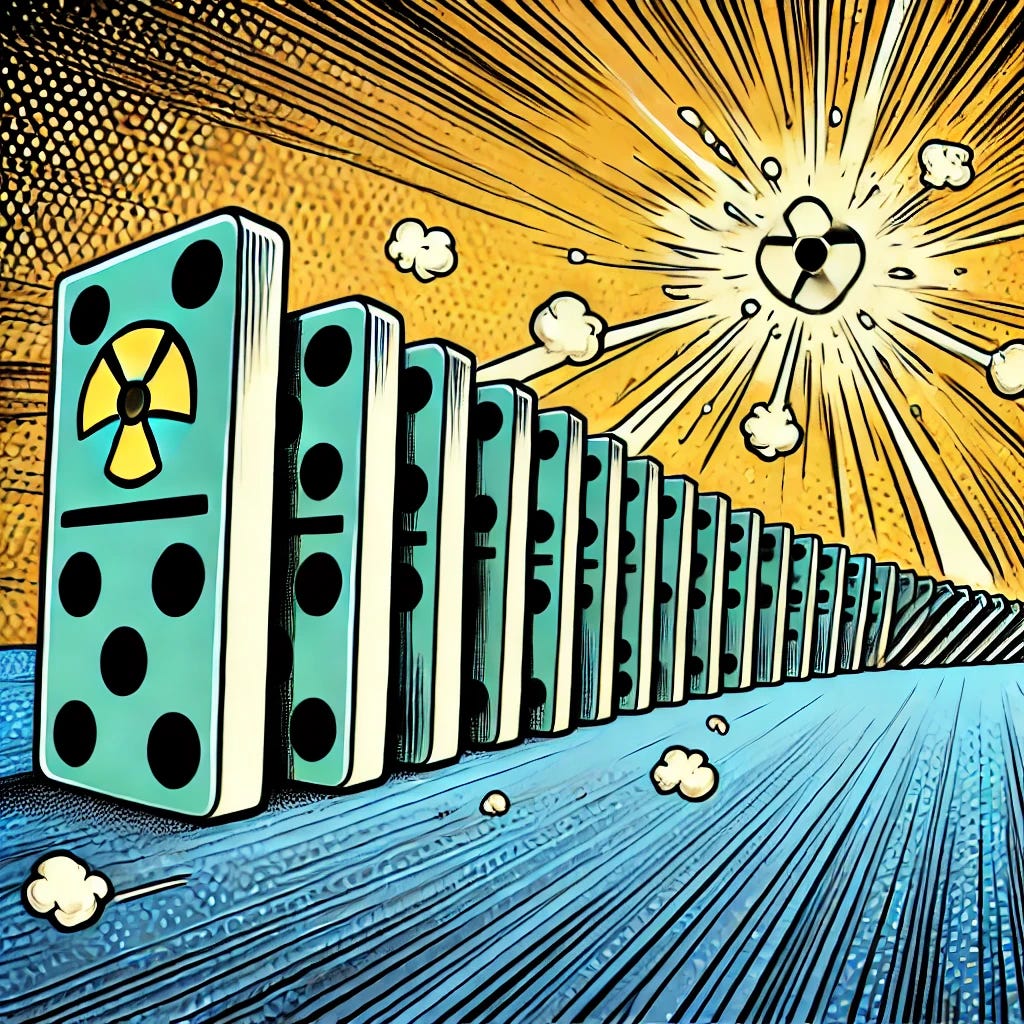Yesterday, I wrote about crushing pressure.
Starting with a pool, then the ocean, then the Earth’s core, we journeyed through ever-higher pressures and imagined what happened each time. We made it all the way past stars and to black holes, but we don’t need to go quite that far today. What happens at the core of our Sun is plenty.
Down there, under the weight of hundreds of thousands of Earths, hydrogen atoms fuse into one another. Saying they “fuse together” sounds pretty blah, but fusion turns one element into another, precisely the process sought after by alchemists and fanatics for millennia. What starts as hydrogen turns into helium.
It seems like something magical takes place, but instead, fusion is the most natural process in the universe, without which there would almost surely be no life. Every time you see a star, you are seeing fusion happen.
Fission, on the other hand, is much more rare, but it’s the main way we humans tap into the power of the atom.
You start with a lot of neutrons. One easy way to get a lot of neutrons in one place is with a bunch of heavy atoms, so that’s what physicists started using when they began inducing fusion reactions during the 1940s.
Uranium-235 or plutonium-239 are really great candidates.
They have 143 and 144 neutrons, respectively, and their nucleus is kept stable in the same way that our Sun stays stable: equilibrium. The strong nuclear force tries as hard as it can to pull on all those neutrons (and their proton cousins), yanking them inwardly all the time with the strongest force in the universe.
At the same time, the electromagnetic force pushes outward, trying to keep any two protons away from one another. Think of this like a referee trying to keep away two small children trying to fight.
While this force is about a hundred times weaker than the strong force, the equilibrium in the nucleus of one of these isotopes is very, very delicate. It wouldn’t take much to shake things up. It’s a bit like a military force watching two evenly matched enemies wage war, then essentially deciding who will win by joining them.
If you can get just one stray neutron to smack into one of these nuclei, the scales are suddenly (and violently) tipped in the favor of that outward pressure. It’s tempting to think about it like this: one single neutron breaks apart a bond between two protons, causing two fragments of the atom to break apart.
That’s intuitive to us, but it’s not quite what happens down at the quantum scale. The rules of common sense don’t really apply, but the explanation is still pretty satisfying: the neutron is absorbed by the nucleus, disrupting that careful balance for good.
These fragments form different, lighter elements than uranium or plutonium, which blast apart from one another thanks to Einstein’s most famous equation, E=MC². When you add the two new atoms up, their mass is always less than that of the original uranium-235 or plutonium-239 atom. That’s where all that energy comes from.
Those two candidates in particular (U-235 and Pu-239) are special in one particularly important way. When one of their atoms breaks apart like this, smashing apart those all-powerful strong nuclear bonds, not only is energy released (making up the difference in mass I mentioned), but so are 2 or 3 neutrons.
It is these 2 or 3 additional neutrons that make this into a chain reaction, not just a one-off event. If one plutonium atom broke apart in front of you, you wouldn’t even notice it.
You need at least millions of these atoms clumped together, and if you’ve had your first cup of coffee already, you’ve probably already figured out that we don’t see that happen anywhere in the world, at least not on its own. Otherwise, there would be spontaneous nuclear explosions happening on Earth.
However, if you put enough tiny clumps of the stuff together, you can make a chain reaction happen. Dominos are a ready example from life you probably already know:
You’re probably also familiar with what happens if you cluster a bunch of matches together, then light one of them:
While these are way more intuitive—the cause and effect makes perfect sense to us at the macro level—the same sort of thing happens at the subatomic scale.
The idea here is that you have enough of something so that one small action can be contagious, in a way. It spreads its action to others like it, creating an effect that is many times greater than that of the individual actor.
This chain reaction only works when you have enough of that individual actor. If you want to show off to your pyro friends (please don’t do this), you need to have a lot of matches. Likewise, you need to have a lot of U-235 or Pu-239 if you want to make a nuclear bomb.
You don’t need to look any further than news headlines to understand how this affects geopolitics. Fortunately for the world, it’s not easy to get enough of this stuff together to make a bomb. Unfortunately, there are multiple potential ways to get it done.
With uranium, while U-235 is the “good” stuff (we call them fissile isotopes), U-238 is what occurs most readily here on Earth. However, if you scoop up some uranium ore, you’ll find a tiny bit of the 235 variation—less than one percent. Spinning in a centrifuge is just one way to separate out the heavier U-238 from the lighter, more valuable stuff.
Plutonium, on the other hand, does not naturally occur in nature, at least not in any significant or stable amounts we know of. It was discovered when we created it from U-238, in fact, and that’s how we can make it today.
For both of these elements, you need to have a lot of technical expertise and a lot of engineering ability even to get started with refining uranium or creating plutonium. You also need a ton of energy, and it’s not exactly a process you can hide from your neighbors.
This process is at the very heart of the US-Iran relationship, and understanding the physical process can help to understand the geopolitical dynamic too.
Could there be a similar sort of critical mass with regard to nations that produce nuclear weapons? Is there a threshold to be avoided at all costs, lest we spiral into oblivion as nation after nation arms itself with nukes?
I don’t have any easy answers for these questions, but I do get the strong sense that it is in the best interest for everyone living in the world today to limit the nations that have nuclear weapons. This goal might be viewed as the lesser of evils, given that this freezes in place the existing power structure. It’s also perhaps easy for me to say this, given that I live in a nuclear superpower at the moment.
Yet, I feel strongly that this is the case. More nations having nukes means more potentially itchy fingers on triggers. More relationships between nuclear nations means much more complexity. Dunbar’s number applies to nations as well as to people.
Much has been made of the Faustian bargain the Allies made during World War II, especially with 2024’s Best Picture winner, Oppenheimer, garnering plenty of attention on the story. I won’t rehash that conversation, but I will say that we still face the same conundrum today, and we can still decide to avoid that critical mass.
Mutually Assured Destruction (appropriately, MAD) is the current main deterrence strategy against using nukes in combat. We’ve whistled past the graveyard more than once, including a cloud that the USSR’s military mistook for an incoming US nuclear missile. The world I grew up in was certainly a MAD world.
Right now, every nation that has nukes seems to be cognizant of the fact that they might destroy the entire world if they use these terrible weapons, and that seems to be enough of a deterrent for now. Inviting other nations in, though, might mean that just one of them views using a nuke as worth the risk.
That’s my que to stop writing for today: I’m in over my geopolitical head! I hope the physics explanation was fun to read, and I hope the whole puzzle is fun to think about, even the geopolitical stuff.
What types of chain reactions do you think most about?








“The idea here is that you have enough of something so that one small action can be contagious, in a way. It spreads its action to others like it, creating an effect that is many times greater than that of the individual actor.”
I think of the US political dialogue or lack there of and the demonization of the other side. January 6 was the match that was contained by democratic rules and those in authority and power not pushing against the guardrails. As more contagion has spread in the last four years, will it be enough for a match to ignite a sustainable reaction?
That is worse case thinking. I cast my vote and regardless who becomes president, senator, congressman or congresswoman, etc., i will make decisions based on the situation and live my life.
Fission reactors rely on division, whereas fusion reactors rely on union. As long as we are divided as people, we may not figure the fusion thing out.